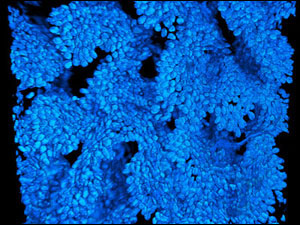
Mouse Colon Closeup Eclipses Competition
MELVILLE, N.Y., Sept. 22, 2006 -- Paul Appleton, a researcher from the Division of Cell and Developmental Biology at the University of Dundee in Scotland, took top honors in Nikon's 2006 Small World Photomicrography Competition for his two-photon fluorescence image of a mouse colon seen through a microscope. He was among 12 who were awarded at a reception held last night at the Helen Mills Theater in Manhattan.

Cell nuclei of the mouse colon (740x), 2-photon fluorescence. Paul Appleton, University of Dundee Division of Cell and Developmental Biology, Dundee, Scotland. (Image courtesy of Nikon)
Appleton's first-prize image depicts the delicate, blue pebbly texture of cell nuclei against a black background. Appleton’s research is designed to further understanding of how cellular changes are regulated and how changes in normal cellular processes contribute to the development of colon cancer.
“Digital microscopy generates tremendous amounts of quantitative information which is used to measure changes in normal cells,” said Appleton. “This imaging capability makes an enormous difference in the amount and quality of the information we are able to collect and analyze.”
Appleton’s research represents two new fields of science, genomics and bioinformatics. Genomics is the study of the flow of information in a cell; bioinformatics is the application of computing to make sense of the huge amount of data coming from genomics.
Images submitted by Nikon Small World winners’ were selected from over 1700 photomicrographs sent to Nikon by scientists and artists from around the globe and judged by a panel of experts. This year, they included the following:
Sir Harold W. Kroto, 1996 Nobel Laureate in Chemistry for his discovery of fullerenes (also known as buckyballs); Cristina Scalet, science photo editor for Time magazine; Vladimir Gelfand, professor of cell and molecular biology, Feinberg School of Medicine, Northwestern University; JD Talasek, director, Office of Exhibitions and Cultural Programs, National Academy of Sciences; and judges consultant Michael Davidson, senior research engineer, National High Magnetic Field Laboratory at Florida State University.
The second-place image, by Raul Galzalez, is of an aquatic bacteria photographed next to a diatom -- a common phytoplankton that generates its energy through photosynthesis; third place went to Jens Rüchel for his photomicrograph of an aquatic worm that lives in shallow coastal regions. Nikon has also awarded several “Images of Distinction” this year. “Nikon’s Small World gives us a glimpse into a world that few people ever see,” said Lee Shuett, executive vice president of Nikon Instruments. “With today’s digital imaging capability we can not only see the smallest objects, we can also study how different objects interact and change over time. Never before in human history have we had this powerful imaging capability to see and analyze so much information about human biology."
The winning microcraphs will be exhibted at science and art museums across the US beginning Oct. 6. They can also be viewed at: www.nikonsmallworld.com
Published: September 2006